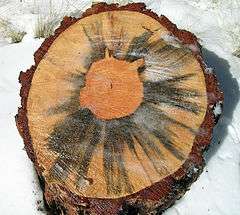Blue stain fungus
| Blue stain fungus | |
|---|---|
 | |
| Grosmannia clavigera | |
| Scientific classification | |
| Kingdom: | Fungi |
| Division: | Ascomycota |
| Class: | Sordariomycetes |
| Order: | Ophiostomatales |
| Family: | Ophiostomataceae |
| Genus: | Grosmannia |
| Species: | G. clavigera |
| Binomial name | |
| Grosmannia clavigera (Robinson-Jeffrey & R.W.Davidson) Zipfel, Z.W.de Beer & M.J.Wingf. (2006) | |
| Synonyms[1] | |
| |
The blue stain fungus, Grosmannia clavigera, is a species of sac fungus. It spreads to lodgepole pine, ponderosa pine, Douglas-fir, and whitebark pine trees from the body and a special structure in the heads of mountain pine beetles. The blue stain fungus has evolved a relationship with mountain pine beetles that allow them to travel from tree to tree on a special structure in the beetle’s heads and stops the tree from producing resin to pitch out or kill the beetle, encouraging the pine beetle infestation occurring all along the Rocky Mountains from Mexico into Canada. The beetles are able to mine and lay eggs while avoiding the tree’s defenses.[2] The 33 Mb genome of this fungus was sequenced in 2009.[3]
The blue stain fungus spores germinate and produce a thread like mass (mycelium) that colonizes the phloem and sapwood. Fungal spores are usually blown away by wind but blue-stain spores are "sticky." This process eventually blocks the nutrient-conducting columns of the tree draining the trees of their nutrients eventually causing the tree to starve to death.[4] The symptoms and signs of blue stain fungus are a blue-gray discoloration of sapwood in wedge shapes of recently killed trees.[5]
Preventing the blue stain would require that unfavorable conditions for the fungus be maintained such as: keeping the wood dry, protecting the wood from mountain pine beetles, and maintaining temperatures above or below ideal growing temperatures.[6] The spread of blue stain fungus can only be controlled by protecting the trees from the mountain pine beetle.
References
- ↑ "GSD Species Synonymy: Grosmannia clavigera (Rob.-Jeffr. & R.W. Davidson) Zipfel, Z.W. de Beer & M.J. Wingf.". Species Fungorum. CAB International. Retrieved 2015-09-21.
- ↑ Dolgin E (2009). "Fungus genome boosts fight to save North American forests". Nature. doi:10.1038/news.2009.928. Archived from the original on September 23, 2009.
- ↑ Diguistini S, Liao NY, Platt D, et al. (2009). "De novo genome sequence assembly of a filamentous fungus using Sanger, 454 and Illumina sequence data". Genome Biol. 10 (9): R94. doi:10.1186/gb-2009-10-9-r94. PMC 2768983
 . PMID 19747388.
. PMID 19747388. - ↑ Ballard, R.G.; Walsh, M.A.; Cole, W.E. (1984). "The penetration and growth of blue-stain fungi in the sapwood of lodgepole pine attacked by mountain pine beetle". Canadian Journal of Botany. 62 (8): 1724–1729. doi:10.1139/b84-233.
- ↑ Christiansen, E.; Solheim, H. (2007). "The bark beetle-associated blue-stain fungus Ophiostoma polonicum can kill various spruces and Douglas fir". Journal of Forest Pathology. 20 (6–7): 436–446.
- ↑ Hiratsuka, Y.; Chakravarty, P.; Miao, S.; Ayer, W.A. (1994). "Potential for biological protection against blue stain in Populus tremuloides with a hyphomycetous fungus, Stachybotrys cylindrospora". Canadian journal of forest research. 24 (1): 174–179. doi:10.1139/x94-023.
- 6. DiGuistini; et al. (2011). "Genome and transcriptome analyses of the mountain pine beetle-fungal symbiont Grosmania clavigera, a lodgepole pine pathogen". PNAS. 108 (6): 2504–2509. doi:10.1073/pnas.1011289108. PMC 3038703
 . PMID 21262841.
. PMID 21262841.
